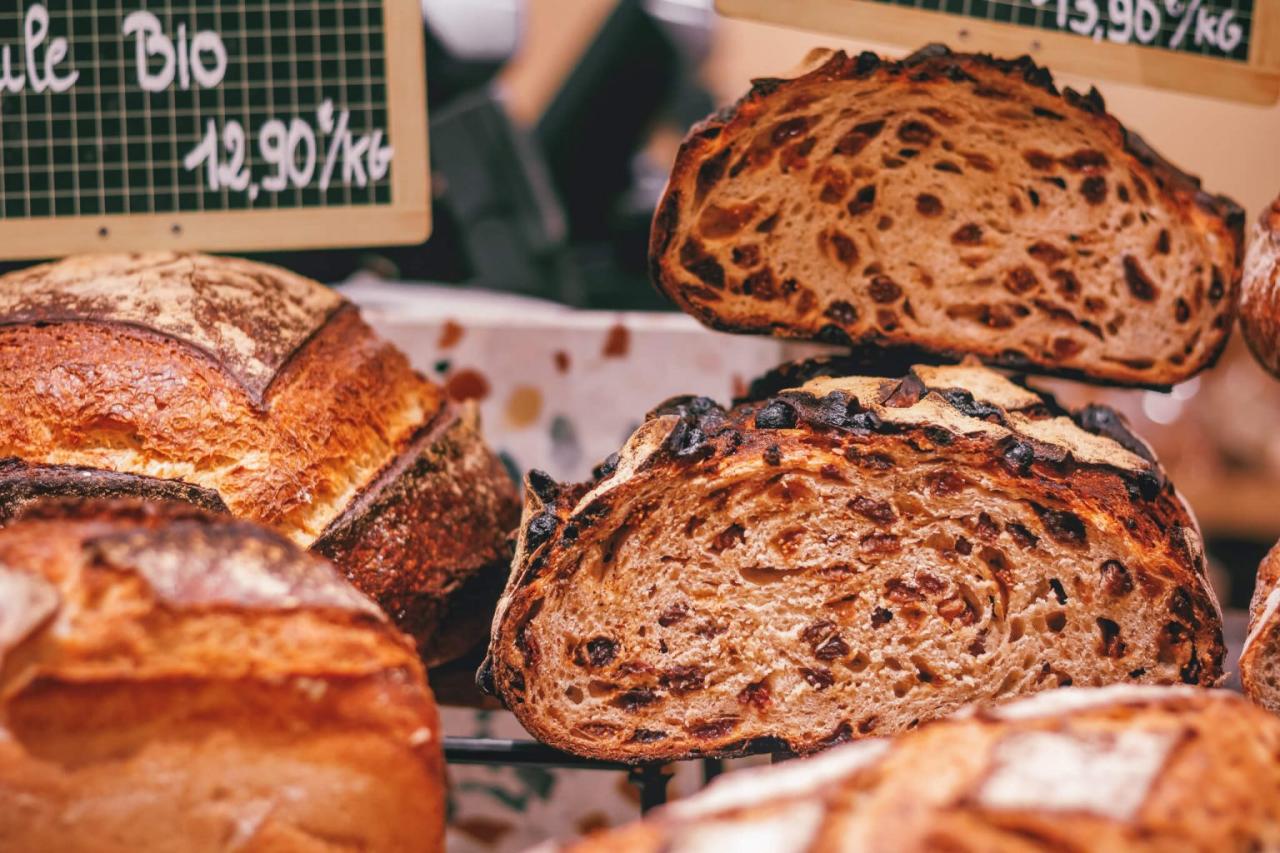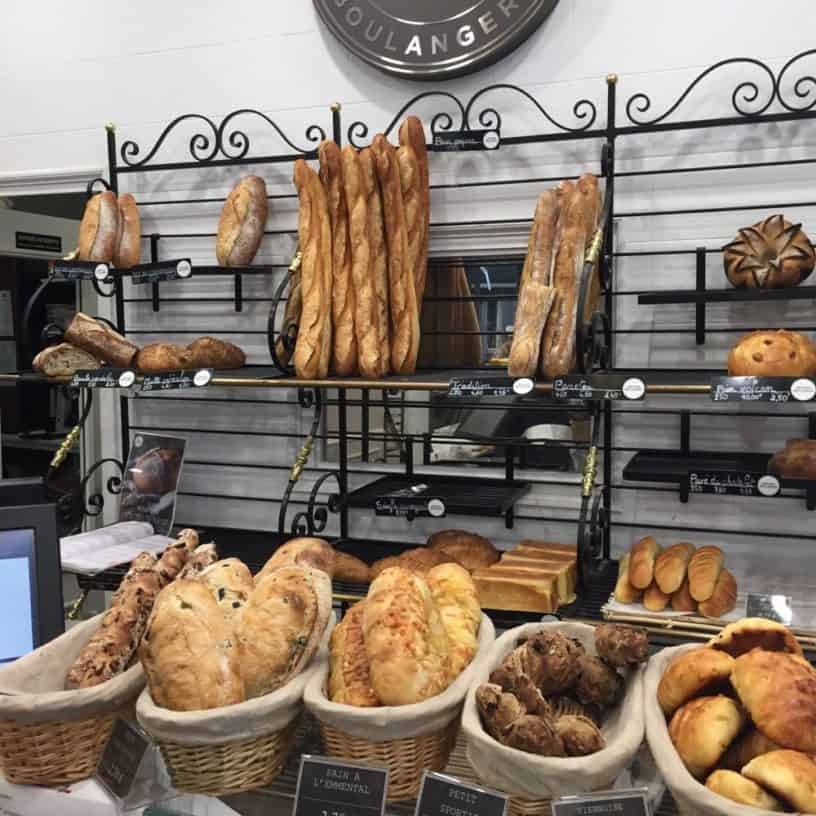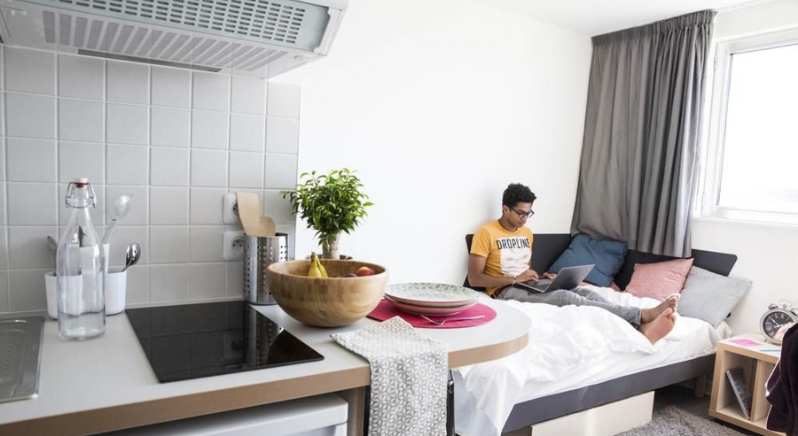Authentic Parisian bakeries outside the main tourist areas offer a captivating glimpse into the heart of Parisian culture. These hidden gems, often found in local neighborhoods, provide a taste of true Parisian baking traditions, away from the throngs of tourists.
Beyond the bustling tourist traps, these bakeries are deeply intertwined with the local community, showcasing the unique flavors and atmosphere of specific Parisian neighborhoods. Their distinct offerings, from the quality of ingredients to the traditional baking techniques, set them apart from the more commercially-oriented bakeries frequented by tourists. This exploration dives into the experience, ambiance, and local connections of these authentic Parisian bakeries, revealing a side of Parisian life rarely seen by visitors.
Introduction to Parisian Bakeries

A Parisian bakery transcends the simple act of purchasing bread and pastries. It embodies a cornerstone of French culture, a place of community gathering, and a testament to the artistry of baking. More than just a shop, it’s an experience.These establishments, often found in residential areas beyond the main tourist hubs, are imbued with a distinct character that sets them apart from other bakeries.
They reflect a deep-rooted tradition, passed down through generations, while simultaneously adapting to modern tastes.
Defining a Parisian Bakery
A Parisian bakery is a traditional establishment, typically smaller in scale than larger commercial bakeries, specializing in the creation and sale of fresh, high-quality baked goods. These establishments often feature a strong focus on classic recipes, using local ingredients whenever possible. The atmosphere is typically warm and inviting, with a focus on quality over quantity.
Key Characteristics
Several key characteristics distinguish a Parisian bakery from other types of bakeries. These include: a strong emphasis on craftsmanship and traditional methods; a reliance on local, seasonal ingredients; and a dedication to creating consistently high-quality baked goods. The intimate setting often fosters a sense of community and encourages repeat customers.
Classic Parisian Pastries and Breads
A Parisian bakery is renowned for its exquisite pastries and breads. Among the most iconic are croissants, pain au chocolat, madeleines, and various types of baguettes, each reflecting the dedication to meticulous preparation and the highest standards. The careful selection of ingredients, and the precise baking techniques, are vital to their distinctive flavors and textures.
- Croissants: These buttery, flaky pastries are a hallmark of French baking, known for their delicate layers and rich flavor. The process of layering the dough and the precise timing of baking are critical to achieving the ideal texture.
- Pain au chocolat: A delightful combination of flaky croissant dough and rich dark chocolate. The perfect balance between the textures and the chocolate’s melt-in-your-mouth quality is a key factor in this pastry’s appeal.
- Madeleines: These shell-shaped, almond-flavored cookies are a delightful treat, with their distinctive texture and subtle flavor. The precise method of creating the molds and the precise timing of baking are essential.
- Baguettes: The quintessential French bread, characterized by its long, slender shape and airy texture. The use of specific flours, yeast, and baking techniques ensures the distinct qualities of a Parisian baguette.
Historical Context and Cultural Significance
Parisian bakeries have a long and rich history, deeply intertwined with French culture. From the early days of artisan bakers to the modern-day establishments, these bakeries have been a focal point of community life, offering more than just sustenance. They are an integral part of daily routines, providing comfort and delight, and serving as social hubs. The meticulous attention to detail and the dedication to tradition in these bakeries have solidified their role in French identity.
Ambiance and Atmosphere
The ambiance of a Parisian bakery is often warm and inviting. The aroma of freshly baked bread and pastries fills the air, creating a welcoming atmosphere. The display of beautifully crafted pastries and breads, and the presence of local customers engaged in conversation, contribute to the overall atmosphere of the place. The intimate scale of these establishments often fosters a sense of community.
The warmth and charm of these places create an experience that transcends the simple act of buying food.
Identifying Hidden Gems

Beyond the bustling tourist hubs, Paris conceals a wealth of authentic bakeries, often tucked away in residential neighborhoods. These hidden gems, cherished by locals, offer a unique glimpse into the city’s culinary soul. These often-overlooked bakeries provide a truly Parisian experience, distinct from the more tourist-oriented establishments.These neighborhood bakeries are more than just places to buy bread; they are vital community hubs.
Understanding the community’s connection to these bakeries reveals the heart of Parisian life. Their unique selling propositions, often less about flashy displays and more about the quality and tradition of their craft, are what make them stand out.
Neighborhoods Known for Their Bakeries
These neighborhoods, outside the central tourist areas, boast a concentration of exceptional bakeries. Discovering them requires venturing beyond the typical tourist routes, into the heart of local life. These are not simply places to grab a quick pastry; they are integral to the community.
- The Belleville district, known for its vibrant atmosphere and multicultural influences, features several excellent boulangeries that showcase a blend of traditional and contemporary styles. This area’s distinct character is reflected in the bakeries, which cater to diverse tastes and preferences.
- In the charming Marais district, a mix of historic buildings and trendy boutiques, you’ll find bakeries that emphasize quality ingredients and artisanal methods. The emphasis on craftsmanship is a defining characteristic of the bakeries here.
- The Canal Saint-Martin area, with its trendy cafes and boutiques, offers a mix of both modern and traditional bakeries. The area’s evolving character is reflected in the diverse offerings of its bakeries.
Discovering Bakeries Beyond Tourist Routes
To uncover these hidden gems, consider local recommendations. Talk to locals, check neighborhood forums, or explore local markets and shops. They often provide the best leads to the best bakeries.
- Neighborhood markets are excellent resources. Look for local markets, especially those held on weekends. These often have stands from local bakeries, providing a chance to taste their products firsthand.
- Local shops, like grocery stores or delis, can provide valuable recommendations. Their staff often have a deep understanding of the local scene and can suggest bakeries that align with specific preferences.
- Online resources, such as local community forums or blogs, are invaluable. They can highlight lesser-known bakeries or local events that provide insights into local culinary scenes.
Local Community’s Connection to Bakeries
The local community often has a deep connection to these bakeries. They are more than just businesses; they are a vital part of daily life.
- Many bakeries are family-run businesses, passing down generations of knowledge and recipes. This family connection is often evident in the atmosphere and quality of the baked goods.
- The bakeries often serve as community gathering points. This can range from morning coffee with friends to impromptu gatherings after a neighborhood event.
- Regular customers often have a close relationship with the bakers. This personal touch fosters a sense of community and trust in the quality of the goods.
Unique Selling Propositions of Hidden Gems
These bakeries offer unique selling propositions that set them apart. These are often centered on the craftsmanship and local ingredients.
- Many bakeries focus on using locally sourced ingredients. This commitment to local produce ensures freshness and authenticity.
- A distinctive approach to traditional recipes is often seen. Modern twists on classic French pastries can provide a unique experience.
- A specific focus on a niche product, such as sourdough bread or specific types of pastries, often distinguishes these bakeries.
Exploring the Bakery Experience
Stepping beyond the throngs of tourists in central Paris reveals a different, more intimate bakery experience. These less-trafficked establishments often offer a glimpse into the heart of Parisian baking traditions, showcasing a distinct approach to quality and customer interaction.Authentic Parisian bakeries, especially those outside the main tourist areas, prioritize the craft of baking. Their focus is on using traditional methods and high-quality ingredients, often sourced locally, leading to a noticeably different experience than the large tourist bakeries.
Typical Offerings, Authentic Parisian bakeries outside the main tourist areas
These bakeries typically offer a broader range of breads, pastries, and treats compared to the often-curated selections found in tourist areas. Their menus showcase a wider spectrum of traditional French pastries, often featuring seasonal variations and local specialties.
Quality and Ingredients
A key difference lies in the quality and origin of ingredients. Bakeries outside tourist areas frequently use locally sourced flour, butter, and other ingredients, reflecting a commitment to traditional recipes and potentially seasonal offerings. This often results in a more nuanced and flavorful experience, a product of the ingredients’ superior quality and freshness. In contrast, tourist-oriented bakeries sometimes use more commercially available ingredients to maintain consistency across a larger scale.
Bread, Pastries, and Treats
The variety of breads available in these bakeries is impressive, encompassing a wide range of styles. From rustic baguettes and sourdoughs to more specialized breads with unique flavors and textures, the selection reflects a commitment to diverse baking techniques. Pastries range from classic croissants and pain au chocolat to regional specialties and unique creations, showcasing the creativity and artistry of the bakers.
Baking Techniques
These bakeries often employ traditional methods, passed down through generations. The focus is on meticulous preparation, precise timing, and the use of natural leavening agents. These traditional methods are crucial in producing breads and pastries with a distinct flavour profile and texture. The difference in the quality of the end product is often a direct result of these techniques.
The baking techniques are frequently a testament to the baker’s experience and skill, offering a tangible connection to the history of French baking.
Service Style and Customer Interaction
The service style in these bakeries is typically more intimate and personalized. Customers often encounter a welcoming atmosphere, and interactions with the bakers are more frequent and informal. This personal touch can create a sense of community and engagement, making the experience more than just a purchase. The service is often a significant part of the overall experience, providing a warm and inviting atmosphere that encourages return visits.
Beyond the Bread and Pastry
Stepping beyond the fragrant displays of pastries and crusty loaves, the Parisian bakery experience extends to a vibrant tapestry of café culture, local social life, and neighborhood traditions. These establishments, often tucked away from the main tourist trails, offer a glimpse into the daily rhythms and communal spirit of the local communities.These neighborhood bakeries aren’t simply places to buy goods; they are hubs of social interaction, integral to the fabric of local life.
They provide a platform for community building, fostering a sense of belonging and shared experience. The ambiance, the interactions, and the history intertwined with the bakery create a unique narrative.
Café Culture and Social Interaction
The café culture within these bakeries is a significant aspect of their role in the neighborhood. Many serve as social gathering spots, providing a place for locals to meet, chat, and enjoy a leisurely coffee or pastry. This fosters a sense of community and connection, often extending beyond mere transactions. A shared croissant or a lively conversation over a cup of coffee becomes a cornerstone of local social life.
The intimate atmosphere often promotes spontaneous conversations and casual encounters.
The Bakery’s Role in Local Social Life
Bakeries act as more than just commercial enterprises; they are integral to local social life. Their role extends to community gatherings, events, and social interactions. Regular customers often become familiar faces, establishing a sense of community and belonging. The bakery becomes a meeting point for neighbors, colleagues, and friends, a space for informal gatherings, and a repository of shared memories.
For example, a weekly gathering of chess enthusiasts in a corner of a particular bakery or a monthly book club meeting hosted by a specific bakery, are not uncommon occurrences.
Unique Activities and Events
Certain bakeries may host unique events and activities, adding another layer to the experience. These events might include seasonal celebrations, workshops, or even small concerts, further enriching the bakery’s social role. For instance, a local bakery might organize a “bread-making” workshop during the weekend or host a Christmas carol concert featuring local musicians. These events add a layer of engagement and draw more customers to the establishment.
Local Atmosphere and Social Interactions
The atmosphere in these bakeries often reflects the local neighborhood’s character. A bustling bakery in a lively neighborhood might exhibit a different vibe compared to a quieter, more intimate establishment in a residential area. The social interactions, whether casual or more formal, mirror the neighborhood’s social dynamic. The way customers greet each other, the conversations that unfold, and the general atmosphere reflect the neighborhood’s character.
For instance, a bakery in a student-heavy area may have a more youthful and energetic atmosphere compared to a bakery in a more mature neighborhood.
History and Traditions
The history and traditions associated with the bakery are often deeply intertwined with the neighborhood’s story. A bakery that has been operating for decades might have witnessed numerous generations of customers, becoming a part of the neighborhood’s collective memory. Its history may be documented through stories told by long-time customers or even through preserved memorabilia. The traditions of a particular bakery could include special recipes passed down through generations or unique customs related to specific occasions.
This history can also be reflected in the bakery’s décor and ambiance. For instance, a bakery in a historic neighborhood might display antique baking tools or have a section dedicated to local artisans’ work.
Seeking out authentic Parisian bakeries outside the main tourist traps is a rewarding experience, often revealing hidden gems. Similar to discovering Parisian street art beyond Montmartre, you’ll find unique charm and vibrant artistry in these less-visited areas. These hidden bakeries, often tucked away in residential streets, offer a true taste of local life. Parisian street art beyond Montmartre provides further insight into this fascinating aspect of Parisian culture, reflecting the city’s diverse artistic expressions.
Exploring these local bakeries is a fantastic way to immerse yourself in the city’s authentic character.
Visual Representation of Parisian Bakeries
Stepping beyond the throngs of tourists, the Parisian bakery scene outside the main tourist areas reveals a unique charm. These establishments, often family-run or with long-standing traditions, offer a glimpse into the heart of Parisian baking culture, distinct from the more commercialized experiences found in popular spots.
Comparison of Authentic Parisian Bakeries (Outside Tourist Areas)
This table showcases three authentic Parisian bakeries located away from the central tourist hubs. It highlights their unique offerings and atmosphere.
| Name | Address | Specialty Items | Atmosphere |
|---|---|---|---|
| Le Petit Fournil | Rue de Belleville, 10th Arrondissement | Pain au chocolat, sourdough bread, and various viennoiseries | Cozy, family-oriented, with a warm and welcoming ambiance. |
| Le Boulanger du Marais | Rue du Temple, 3rd Arrondissement | Baguettes, croissants, and artisanal breads with unique flavors | Noisy but lively, with a local feel, and the scent of fresh baked goods fills the air. |
| Le Pain d’Épices | Rue des Abbesses, 18th Arrondissement | Pain de campagne, fruit tarts, and traditional French pastries | Quaint, with a vintage feel, and often frequented by locals. |
Contrast of Bakeries (Tourist vs. Non-Tourist)
This table contrasts the experience of a tourist-centric bakery with one found further from the main tourist areas.
| Feature | Tourist Bakery | Non-Tourist Bakery |
|---|---|---|
| Ambiance | Often crowded, with a fast-paced atmosphere, designed for quick service and tourist purchases. | More relaxed, local atmosphere, with a slower pace, more focused on community interaction. |
| Quality | Can sometimes prioritize volume over quality, offering familiar items, perhaps with slightly less emphasis on detail or tradition. | Typically emphasizes quality ingredients and craftsmanship, with a greater focus on unique and traditional methods of baking. |
| Customer Service | May be more focused on efficient transactions, with staff potentially less engaged in interaction. | Often features friendly and welcoming service, with staff eager to share knowledge about their products. |
Types of Bread in Authentic Parisian Bakeries
Authentic Parisian bakeries, particularly those outside tourist areas, often feature a wide array of bread types. The following are common examples.
| Name | Description | Ingredients |
|---|---|---|
| Baguette | A long, thin loaf of bread, characterized by its crisp crust and airy interior. | Flour, water, yeast, salt. |
| Pain de Campagne | A rustic, country bread, with a slightly chewy texture. | Flour, water, yeast, salt, sometimes seeds or herbs. |
| Brioche | A rich, buttery bread, often used for sweet pastries or sandwiches. | Flour, butter, eggs, milk, yeast, sugar, salt. |
| Sourdough | A tangy bread made with a naturally fermented starter. | Flour, water, sourdough starter, salt. |
| Pain au Levain | A bread using levain as a leavening agent. | Flour, water, levain, salt. |
Parisian Pastries in Authentic Bakeries
These are common examples of pastries found in authentic Parisian bakeries outside tourist areas.
| Name | Description | Preparation Method |
|---|---|---|
| Madeleines | Shell-shaped, light, and often buttery cookies. | Baked in specific molds, often using a combination of butter, eggs, and flour. |
| Éclairs | Choux pastry filled with cream. | The choux pastry is piped into a specific shape, filled with cream, and then glazed. |
| Fruit Tart | A pastry with a sweet filling of fruit and a flaky pastry crust. | A pastry crust is prepared and baked, then filled with fruit and baked again. |
Visual Representation of a Parisian Bakery Scene
Imagine a bustling Parisian bakery outside the tourist zones. Sunlight streams through the front windows of a small, family-run bakery, illuminating the display cases filled with glistening pastries and loaves of bread. The aroma of freshly baked goods wafts through the air, mingling with the murmur of conversation between customers and the rhythmic clatter of kitchen utensils. Locals gather, some pausing for a quick pastry and coffee, while others engage in friendly chatter with the baker.
The bakery’s exterior, perhaps with a vintage facade, is adorned with a simple sign that speaks to the history of the place. The overall scene exudes a sense of warmth, community, and the simple pleasure of a daily ritual.
Local Connections
Authentic Parisian bakeries outside the main tourist areas often foster strong ties with their local communities. These bakeries are more than just purveyors of delicious pastries; they are vital components of the social fabric, contributing to the local economy and preserving culinary heritage. This often involves direct relationships with local farmers and suppliers, a focus on seasonal ingredients, and a commitment to supporting the wider community.These bakeries understand that their success is intrinsically linked to the prosperity of the local area.
Their commitment to local sourcing not only ensures high-quality ingredients but also strengthens the local economy by supporting farmers and producers. The bakers often have a deep understanding of the specific qualities of their local ingredients, using them to create unique and flavorful products.
Local Farmers and Suppliers
These bakeries often have strong relationships with local farmers, ensuring the use of fresh, seasonal ingredients. This direct sourcing often means that the bakeries are able to offer products with a more pronounced flavour profile, showcasing the unique character of the region.
- Many bakeries partner with local farms to procure ingredients like wheat, fruits, and vegetables. This ensures the freshest ingredients are used in their baked goods.
- These relationships frequently extend to the procurement of milk, eggs, and other dairy products.
- Bakeries that focus on seasonal ingredients create unique and exciting seasonal menus that reflect the bounty of the local area.
Role of Local Artisans and Ingredients
Local artisans play a critical role in the production process, contributing their skills and knowledge to create high-quality products.
- Many bakeries utilize local artisans for tasks like crafting specific tools or producing decorative elements.
- Local ingredients, such as specific types of flour or unique fruits, contribute to the unique character of the baked goods.
- The utilization of local ingredients often results in products with a distinctive flavour profile, reflecting the terroir of the region.
Contribution to the Local Economy and Community
These bakeries contribute significantly to the local economy and community.
- Employment opportunities are created through the bakery operations, supporting local families and individuals.
- Bakeries often engage in local community events, strengthening their connections with residents and contributing to the social life of the area.
- The patronage of local bakeries provides a source of revenue for local suppliers and farmers, further stimulating the local economy.
Preservation of Local Traditions and Culinary Heritage
Bakeries often play a crucial role in preserving local culinary traditions and heritage.
- Many bakeries maintain traditional recipes and baking techniques, ensuring their continuity through generations.
- The use of locally sourced ingredients and traditional methods help to preserve the unique culinary identity of the region.
- These bakeries contribute to the cultural landscape of the area by offering a glimpse into local culinary history.
Examples of Family-Run or Community-Tied Bakeries
Family-run bakeries are common in many areas, often with deep community ties.
- Many bakeries have been passed down through generations, maintaining a connection to the local community.
- The personal touch and strong community ties of family-run bakeries create a unique atmosphere.
- These bakeries often act as a central gathering point for locals, fostering a sense of community.
Unique Elements

Beyond the ubiquitous croissants and baguettes, authentic Parisian bakeries outside the main tourist areas often boast unique elements that set them apart. These elements, often rooted in family traditions or local history, contribute significantly to the bakery’s character and authenticity. These hidden gems often hold the key to understanding the evolving culinary heritage of the city.These unique aspects often stem from specific recipes passed down through generations, reflecting the local terroir and its particularities.
They also encapsulate the history and traditions of the area, which is integral to the authenticity of these bakeries. Their role extends beyond just providing delicious pastries; they are integral to the fabric of their local communities.
Specific Recipes and Family Traditions
Family-owned bakeries often preserve unique recipes that have been passed down through generations. These recipes, often adapted to local tastes and ingredients, contribute significantly to the bakery’s distinct identity. The use of regional ingredients, such as a particular type of flour or a specific fruit, can result in a flavor profile that is quite different from the standard Parisian fare.
These distinctions showcase the dedication and expertise of the bakers, as well as the rich culinary history of the area. For example, a bakery might feature a traditional brioche recipe that includes a secret ingredient like locally sourced honey or herbs.
Historical Significance and Local Events
Some bakeries are linked to significant historical events or figures. Their presence in a particular location might be deeply intertwined with the area’s history. For instance, a bakery might be located in a building that once housed a famous local artist or writer. This connection to the past adds an extra layer of intrigue and authenticity to the bakery experience.
Furthermore, these bakeries often participate in or host local events that reflect the neighborhood’s culture, from festivals to community gatherings.
Preservation of Regional Culinary Traditions
These bakeries play a vital role in preserving regional and local culinary traditions. They often feature regional variations of classic pastries, demonstrating the evolution and adaptation of recipes across different neighborhoods. By upholding these traditions, these bakeries contribute to the preservation of a specific culinary heritage. For instance, a bakery in a working-class neighborhood might feature a particular type of bread that has been a staple for generations.
These variations highlight the diverse culinary landscape of Paris, beyond the well-known tourist hotspots.
Closure: Authentic Parisian Bakeries Outside The Main Tourist Areas
In conclusion, discovering authentic Parisian bakeries outside the main tourist areas provides a deeper understanding of Parisian culture and the rich tapestry of local life. These hidden gems offer a unique experience, showcasing the dedication to quality ingredients, traditional baking techniques, and strong community ties. Their role in local social life and preserving culinary heritage makes them an essential part of the Parisian experience, inviting a true immersion into the city’s soul.
Detailed FAQs
What distinguishes a Parisian bakery from other bakeries?
A Parisian bakery typically emphasizes high-quality ingredients, traditional baking techniques, and a focus on classic Parisian pastries and breads. The ambiance and service style often reflect a strong sense of community and tradition.
How can I find these hidden bakeries?
Exploring local neighborhoods, checking local market listings, and seeking recommendations from locals are good ways to uncover these hidden gems beyond the usual tourist routes.
What are some examples of classic Parisian pastries?
Croissants, pain au chocolat, éclairs, and madeleines are just a few examples of classic Parisian pastries.
What role do local markets play in discovering these bakeries?
Local markets often feature these bakeries, offering a chance to see their products and engage with the community.






Leave a Reply